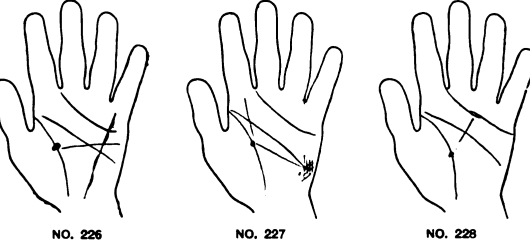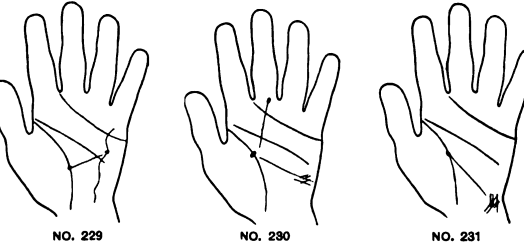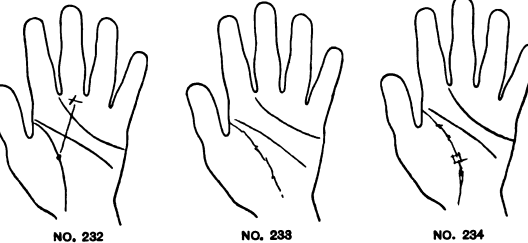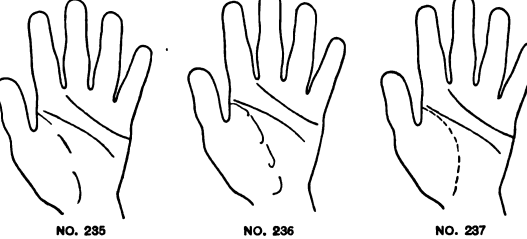Defects on the Line of Life
Table of Contents
With the idea in mind that an island in the Life line is a period of delicate health, you will always be warned, and begin the search for its cause.
Do not be in a hurry; look the entire hand over, consider everything. This cannot be done hastily. Bring to bear every point relating to health and apply it to the island. Proceed with care, and you will be able to locate the cause and effect of every one.
Dots on the Life line (224) are rare.
They are indications of acute illness or of accident. They vary in size from mere pin points, hardly noticeable, to large holes which destroy the line. They are found of all colors, and their importance must be graded by size and color. White dots are the most harmless, and their meaning must be searched for in the hand according to the method of locating disease heretofore explained.
Red dots indicate a febrile tendency, and the deeper the color the more accurate is this reading. When of a deep crimson and purplish hue, they portend grave fevers, such as typhoid, typhus, and the like. In all cases they are useful in locating a point of special incident in the life of a subject, and will precede islands, chains, and other defects, thus showing that the illness recorded was of such severity that the constitution did not again become strong.
A dot on Life line followed by an island and a chained line, with a line running to a bar, a dot, a small island, a cross, or a star on the Head line (225), will show that an attack of brain fever undermined the constitution, and complete recovery did not follow.
A dot on Life line connected by a line to Upper Mars and an islanded line of Mercury (226) will show that the illness was bronchitis or other throat trouble.

A dot on Life line connected by a line to Upper Moon, which has a grille, and a line running to Mount of Jupiter (227), shows the illness to be inflammation of the bowels.
A dot on Life line connected by a line with an island, dot, or a cross under Apollo (228) shows the illness to be heart disease. A dot on Life line connected by a line with a dot, a bar, or a cross on a wavy line of Mercury (229) shows the illness to be bilious fever.

The dot on the Mercury line indicates the acute attack; chronic biliousness is shown by the wavy line. A dot on Life line, with cross-bars, a grille, a cross, or a poorly formed star on the Middle of Moon, shows the illness to be gout (230).
This is emphasized by a line running from a dot on Saturn. A dot on Life line connected by a line with a grille, cross-bars, a cross, or poorly formed star on Lower Moon (231) shows the attack to be kidney or bladder trouble of an acute nature. If on the Life line a dot be seen which is pronouncedly yellow in color, it will indicate without further confirmations an attack of bilious fever.
When a dot is seen on the Life line connected by a line with a cross on Saturn (232), it will indicate an accident, as Saturnians are predisposed to accident.

Breaks in the Life line are often seen (233), and vary in their seriousness according to the kind of a line which is present, how wide the breaks are, and how repaired. When the Current, travelling along the Life line, encounters a break, it must get past it into the line again, and it is the ease with which this can be accomplished which makes a break more or less serious.
A break occurring in a deep, strong line is less serious than one which appears in a broad and shallow or chained line. In the deep line the Current is flowing with volume and force at the time it reaches the break, and consequently it has the benefit of its own momentum to carry it past the break and into the line again.
I have seen breaks in deep and strong Life lines where the line has subsequently cut its way through the intervening space, forming a good line.
With shallow or chained lines, the Current is moving sluggishly when the break occurs, and there is not the momentum to assist in lessening the damage. All breaks indicate a check or impediment to the health, consequently to the life of the subject, and these impediments come either from illness or accident.
The matter of accidents is hard to diagnose, but I follow the rule that in a hand which is healthy in every other way, a break in the Life line should be read as an accident. Sickness in such a hand would be shown in some other way than by a break. In a number of hands in which fine Life lines were noted and perfect health otherwise shown, breaks were verified as accidents. There is no question as to their indicating jars to the health whenever seen.
Numerous instances are encountered where the cause of the break is easily located by health defects seen on the Mounts, by chance lines, or individual signs. Small breaks which are at once repaired (234) need not be considered as more serious than islands or dots, but wide breaks unrepaired (235) must be considered as a menace to the life.

All tendency of the ends of the line to turn back after a break (236) is gravely serious. The wider the separation of the ends and the more the ends hook, the more hopeless is the possibility of recovery.
With every break, note how wide it is, how the ends oppose each other, what repair possibilities are present, and from this point of view estimate the danger.
If the line is filled with a series of small breaks (237), the effect will be like a chained line, the health will be intermittent, the vitality impaired, and the constitution unrobust. If after each break the line becomes thinner (23S), the vitality is diminishing, and the subject less able to resist disease after each attack. He will gradually grow weaker until his vitality is dissipated. This line is both an indicator of constitutional weakness and of special attacks of disease.
Each break will mark the time of some illness. With such a line as 238, you will not find different acute disorders occurring with each break, but the subject has a chronic trouble which recurs at frequent intervals.

The nature of this disorder can be located from the Mounts and by other health indications. The line may start thin, and after each break grow deeper (239). In this case after the first few years of life the breaks will not come so close together, and it will show that the subject is gradually overcoming his difficulties.
To diagnose what has occasioned each break in the Life line, the method of procedure is the same as applies to other defects in the line. The Mounts will show defects, chance lines will point to special marks of disease, and in every way the manner of locating the cause of breaks is the same as in the case of islands, dots, and other defects.
The character of the line after the break must be noted to determine the extent of damage which has been done. If after a break an island is formed (240), the disease which caused the break creates a period of delicacy, the duration of which is shown by the extent of the island.
The same reading will apply if a chained line forms after a break (241).

With such a marking as this there will be poor chance of complete recovery. When breaks occur at about fifty years of age (242), with the line growing very thin just before the break, and seeming continually to grow thinner until the break occurs, it shows the gradual waning of vital force until it runs out; that a period of great weakness comes on when there is not enough strength left to resist disease, and an illness recorded by the break occurs.
If the line continues after this break it will begin very thin and gradually grow stronger, showing that the health returns by degrees. The breaks in a Life line may be repaired by overlapping ends of the line, sister lines, squares, and in other ways.
These repair signs, in whatever form, will be recognized by their tendency to turn the Current back into the line again, and their repair of the line is complete in proportion as they succeed in doing this.
Splits on the Life line (243) divert a portion of the Current from the main channel.